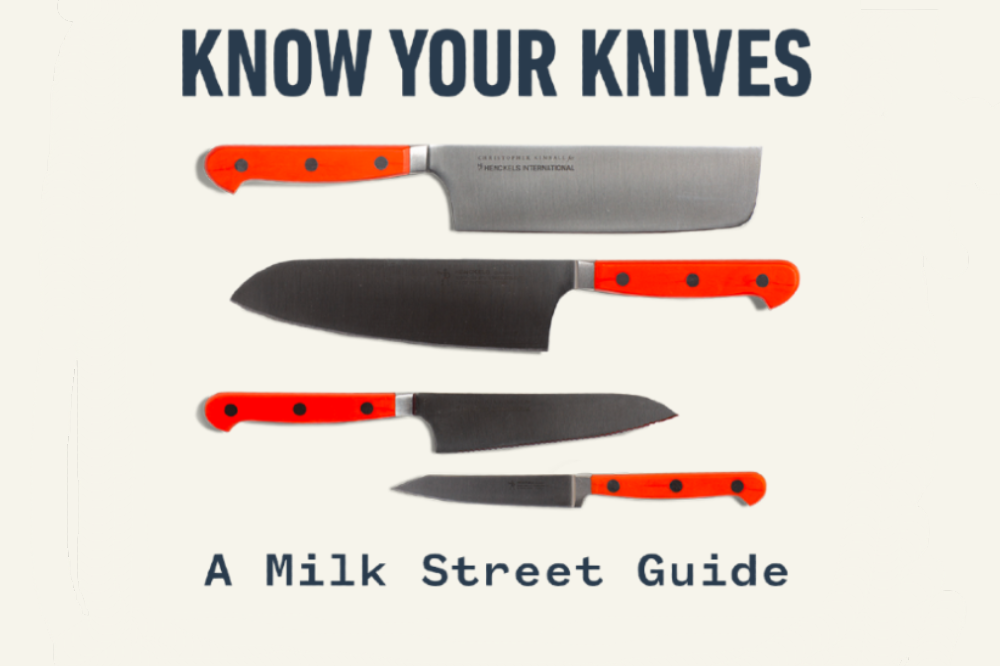It’s helpful to think of kitchen knives in the same terms as shoes. Much as how a boot that works for hiking isn’t great for dancing, the ideal blade for slicing carrots isn’t going to work for chopping chickens. Nor can you easily peel an apple with a cleaver. That’s not to say you need a big collection of knives—just the right one for the right job.
As travel and experience have changed the way we cook at Milk Street, it also has shaped our tool choices. I’ve come to love the form, function and aesthetics of Japanese-style kitchen knives, which generally are lighter, thinner and made from harder steel than stouter European-style knives. They’re also sharpened to a finer edge, which can better make thinner slices and more precise cuts. So there’s no need to make do with an awkwardly big chef’s knife—which hasn’t really changed in shape since the days of the medieval dagger—when a more nimble knife will be more effective and safer.
Here are the five knife styles every home cook should have, plus our own hybrid Kitchin-to and Kitchin-tan designs that check many boxes all in one.
Japanese Nakiri Knife
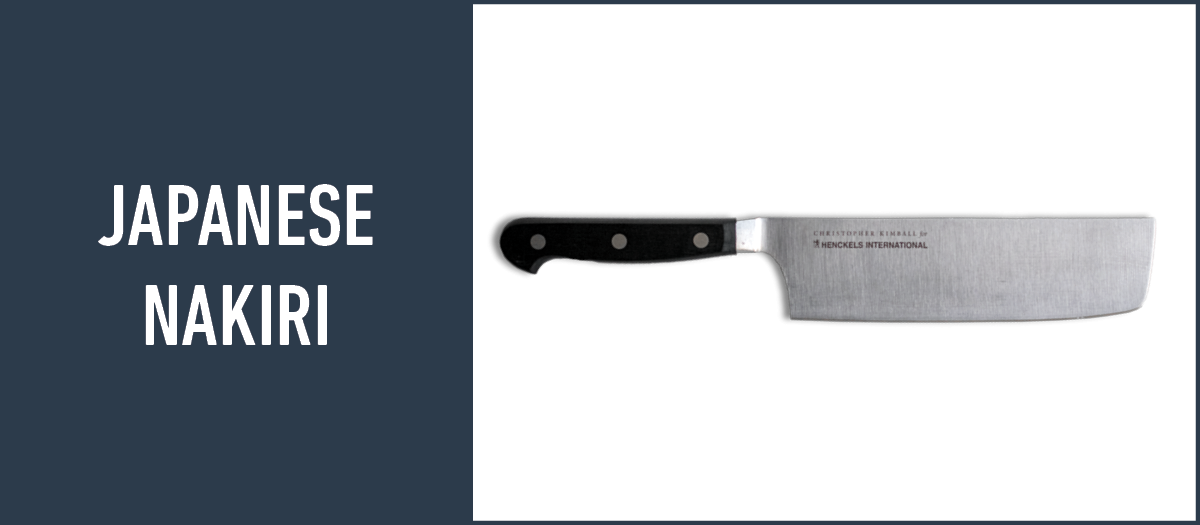
WHAT IS A NAKIRI KNIFE?
The nakiri is a precision Japanese knife designed for perfect vegetable prep. It may look like a simple, slim rectangle, but its thin blade and roughly 17-degree bevels (each side of the sharpened blade) slice through vegetables with ease. The predominantly flat cutting edge makes full contact with the board for clean slices (think of those times you thought you had cut all the way through a bell pepper or tomato only to find it still attached.) The broad, flat blade—and absence of a pointed tip—makes it easy to visualize the size of a dice or matchstick slice and keep your fingers safe.
HOW TO USE A NAKIRI KNIFE
A nakiri’s mid-length, flat blade is ideally tailored for clean push-and-pull slicing and straight up and down chopping. Without much curve to the blade, it’s not ideal for rock chopping or mincing, but is the perfect tool for a veg-heavy diet where tidy knife work really pays off in uniform cooking and aesthetics.
TIPS AND TRICKS
The broader blade works well for smashing ginger or garlic and serves as a bench scraper to transfer chopped foods to a hot pot or mixing bowl.
WHAT NAKIRI KNIFE TO BUY
We partnered with Henckels to produce our ideal featherweight version of a nakiri, which features a traditional flattish profiled blade and mid-sized length mated to a western-style durable polymer handle.
Chinese Cleaver
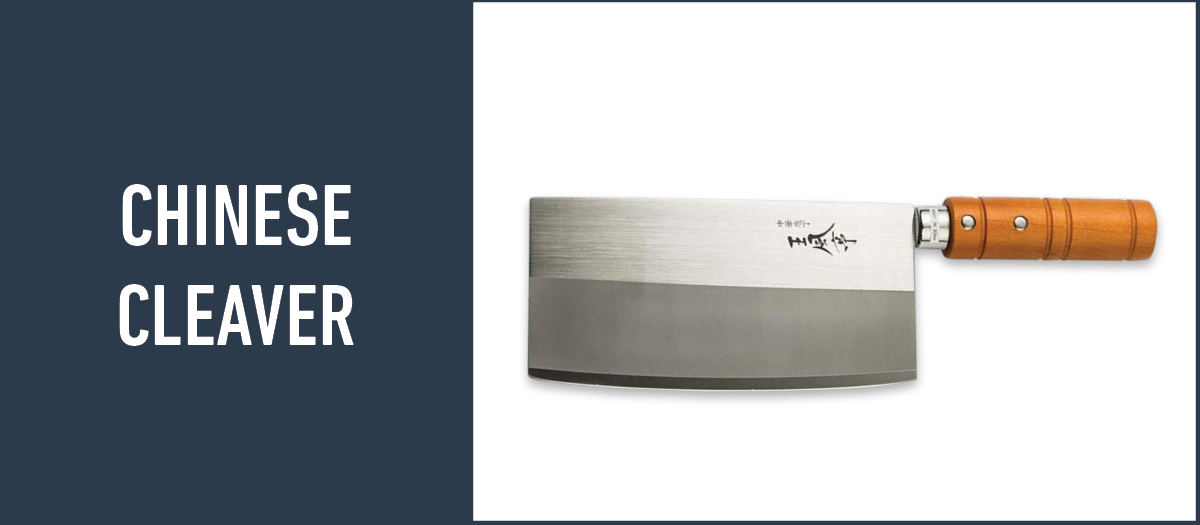
WHAT IS A CHINESE CLEAVER?
Chinese cooks are adept at using a tall, long cleaver for every kitchen task. The forward-heavy blade balance means that the cleaver requires less force for chopping—it does some of the work for you. The traditional wooden, barrel-shaped handle fills the palm for control, especially when you need a secure grip when using a fair amount of force.
HOW TO USE A CHINESE CLEAVER
There’s little a Chinese-style cleaver can’t do once you get the hang of the tall, weighty blade. We tend to favor them for chopping large batches of vegetables or meat, for soups and stews, splitting thick-skinned winter squash, chopping a rack of ribs or spatchcocking bony chickens (with a caveat: some thin-bladed Chinese vegetable cleavers, called cai dao, are best reserved for delicate vegetables). While the stubby barrel handle is comfortable for most, Chinese cleavers really are designed to be choked up tight on the knife spine for the best control.
TIPS AND TRICKS
Use the broad blade for smashing garlic cloves and ginger coins to paste. It’s also our favorite knife for slicing chicken or pork cutlets because the broad blade makes it easy to ensure evenness. I’ve even used them for splitting cake layers.
WHAT CHINESE CLEAVER TO BUY
The Japanese-made Fuji FA-70 cleaver is a little smaller than most Chinese cleavers for better control and features an arched blade for rock chopping and mincing (it’s a great tool for mincing large bunches of herbs).
Paring or Petty Knife
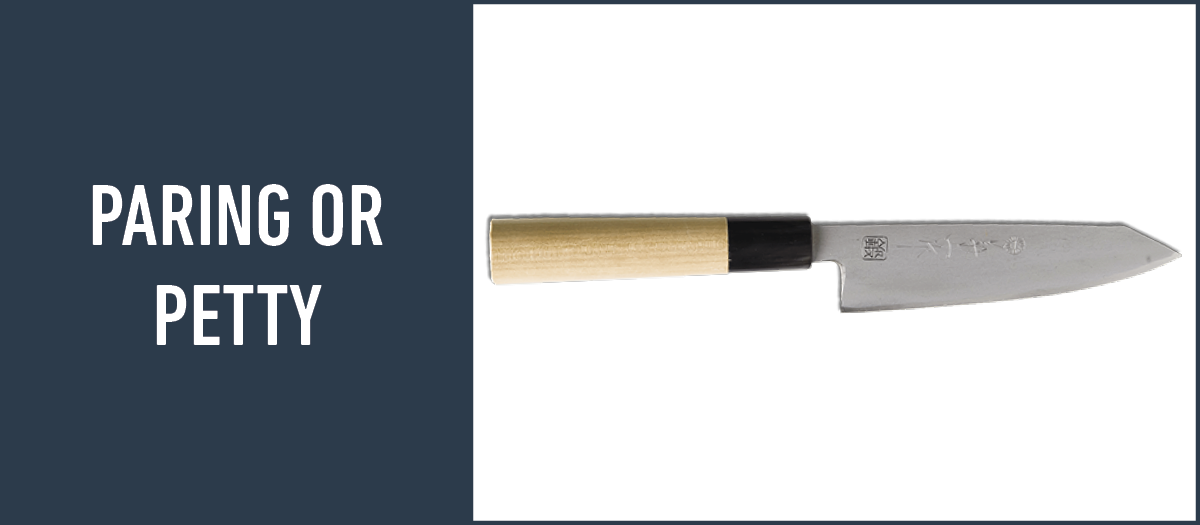
WHAT IS A PARING KNIFE?
A small knife is essential for fine detail work. Paring knives—or what the Japanese call “petty” knives—come in all shapes and sizes, so it’s a matter of matching to your cooking style and size preference.
HOW TO USE A PARING KNIFE
For peeling fruits and vegetables, fine detail work, mincing garlic or shallots, trimming meats and fish. I also use them for most chicken butchery—short of spatchcocking or splitting through the breastbone. A nimble knife easily negotiates tight joints and cartilage.
TIPS AND TRICKS
Paring knives are great for deseeding fresh chilies. Just slice off the stem and run the blunt backside of the blade around the white core, then tap out the seeds.
WHAT PARING KNIFE TO BUY
We tend to favor blades in the 4- to 5-inch range, which are more practical than shorter knives. We partnered with Henckels to develop a traditional Western-style 4-inch paring knife with a scalpel-like “kiritsuke” style tip, which makes it effective for fine detail work. Or, the longer and taller blade of the 6-inch Kikuichi Kokaji Petty Knife makes it more adept than shorter knives for a broader range of tasks, yet it still is incredibly lightweight for better control. This is the ideal picnic or camping knife; it also is great for everything from dicing small vegetables to breaking down roasts for stew meat.
Serrated Knife
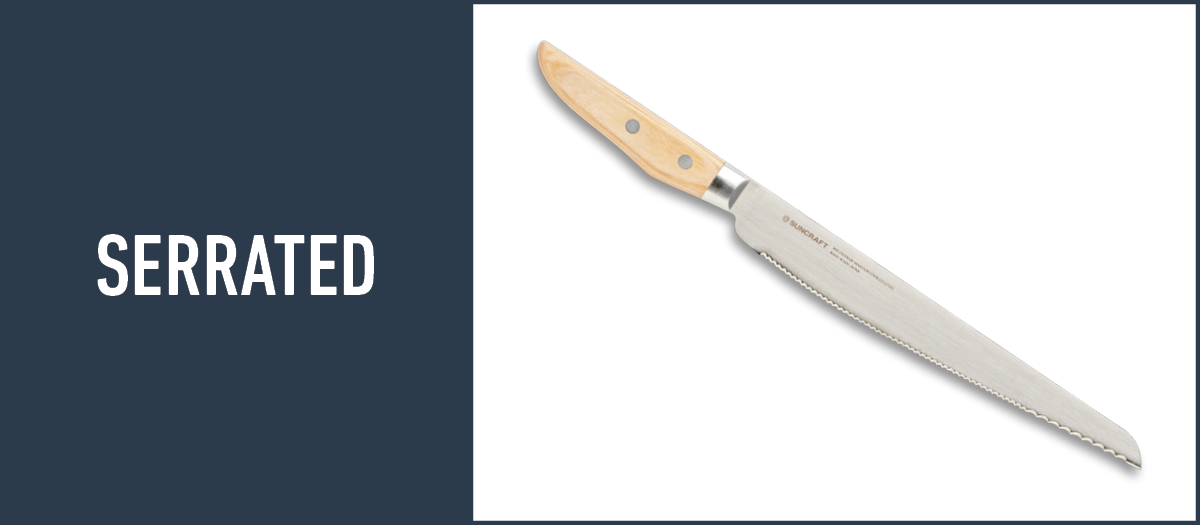
WHY DO I NEED A SERRATED KNIFE?
Every kitchen needs a serrated knife that will cut through anything and everything, from thick-crusted sourdough and tender-crumbed sandwich bread to thick-skinned fruits and vegetables. And many serrated knives are great all-purpose knives ideal for cooks who don’t want to think at all about maintenance. They stay sharp essentially forever.
HOW TO USE A SERRATED KNIFE
The 5-inch utility knife can be used for nearly any type of cut. For the Seseragi, be sure to use the full length of the long blade for clean, easy slicing. The three-step serration pattern effortlessly slices through any style of bread. And with the Opinel Brunch Knife, the 4½-inch broad blade and rounded tip are great at scraping the bottom of jars and spreading butter and jam on toast.
TIPS AND TRICKS
The 5-inch serrated utility knife may be the best sandwich knife around. The serrated edge cuts through crusty and soft bread without tearing or smashing it, it can easily pierce the skin of tomatoes and cucumbers, and the broad blade is the perfect size for slathering mayonnaise or other spreads.
WHAT SERRATED KNIFE TO BUY
Depending on your cooking style and affinity for sharpening, you’ll want to choose either a long serrated bread knife or something like the 5-inch serrated utility knife we designed with Henckels. The utility knife has a unique microserrated edge that is only available on this knife and will stay sharp for ages. Microserrations make this medium-sized knife perfect for odd jobs such as slicing bread and cutting sandwiches, slicing thick-skinned fruits, or even carving a roasted chicken.
For a long bread knife, I’ve tried dozens of different brands, and the Seseragi serrated knife by Suncraft cuts with remarkable ease. The thin, arced blade features grippy serrations at the tip and finer, more delicate serrations towards the handle terminating in a short section of plain edge.
Or for smaller jobs, Opinel's Brunch Knife might be the new favorite knife you never knew you needed: a breakfast knife that actually cuts. The blade is partially serrated to slice crusty toast and chewy sausages—it's not overly sharp, just keen enough to get the job done without a struggle.
Milk Street’s New Hybrid Knife Designs
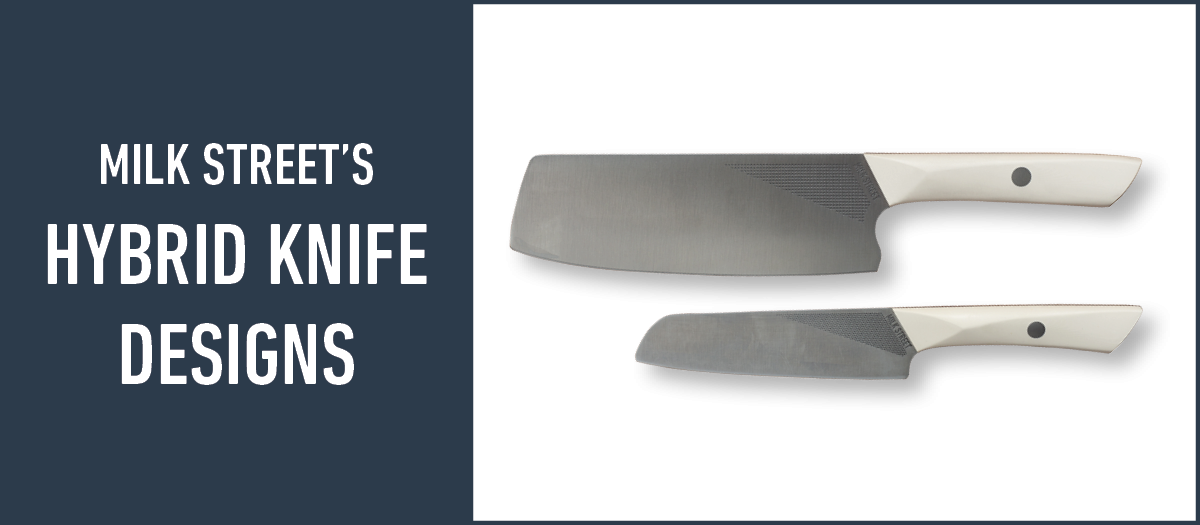
WHAT DO YOU MEAN, HYBRID KNIVES?
We took the top features of our favorite knives and synthesized them into two uniquely Milk Street blade designs that will take care of all your chopping, slicing and dicing needs.
The large Kitchin-to features much of the height of a Chinese vegetable or tall nakiri mated to a santoku’s sheepsfoot tip and curved blade geometry, which works with any cutting style. We designed its ergonomic micarta handle to be broad at the top to fill the palm, narrow to the bottom for fingers to grip and angles toward the blade’s spine to facilitate a comfortable pinch grip. The blade was machined with a fine filework pattern to provide traction for fingertips.
The Kitchin-tan utility knife is designed as a true pinch-hitting companion to the larger Kitchin-to. It borrows design ideas from some of our favorite smaller Japanese knives—a thicker handle for control, broad blade, rounded tip and straight cutting edge. It’s small enough to choke up on for peeling garlic or trimming mushrooms, though long enough to slice, dice and mince onions, garlic and shallots. The handle is a scaled-down version of the Kitchin-to, designed for a steady, controlled pinch grip hold. For those with smaller hands, the Kitchin-tan can be an all-purpose knife
HOW TO USE A HYBRID KNIFE
Kitchin-to and Kitchin-tan knives are designed as a complementary set for all-purpose service. There’s little knife work one or the other can’t handle. Both feature flat blades for clean slicing that curve to the tip for rock chopping and mincing.
WHAT HYBRID KNIVES TO BUY
The Kitchin-to and Kitchin-tan knives are exclusively sold at the Milk Street Store and can be purchased individually or as a set.
Join the conversation on Facebook, Twitter, Instagram and Pinterest!
